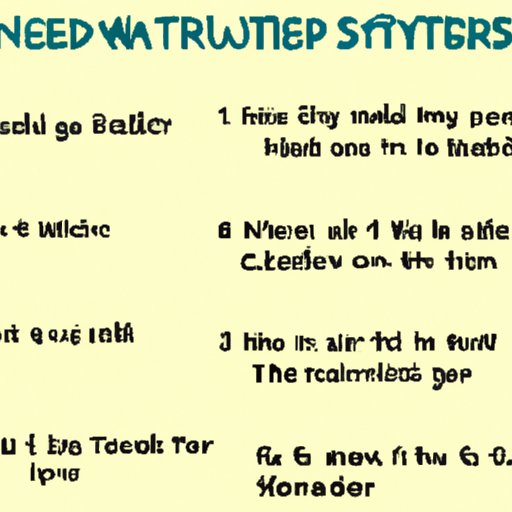Introduction
Writing with numbers can be a tricky task for many authors, especially when it comes to deciding whether to spell out numbers or to use numerals. Knowing when and how to spell out numbers is an important skill for writers, as it ensures that their work is consistent and clear. To help readers better understand the nuances of writing with numbers, this article will explore the rules of spelling out numbers in writing and provide a comprehensive guide for mastering the art of writing with numbers.

Exploring the Rules of Spelling Out Numbers in Writing
When it comes to writing with numbers, there are certain rules and guidelines that need to be followed. These rules vary depending on the context in which the numbers are used.
General Writing Guidelines
In general, it is recommended that numbers from one to nine should be spelled out, while larger numbers should be written using numerals. For example, “seven” should be written out, while “17” should be written using numerals. Additionally, when writing a sentence that includes both small and large numbers, it is best to use the same form of writing throughout the sentence. For example, if a sentence begins with a number spelled out, all other numbers in the same sentence should also be spelled out. If a sentence begins with a number written in numerals, then all other numbers in the same sentence should also be written in numerals.
Specific Rules for Commonly Used Words
In addition to the general rules for writing with numbers, there are also specific rules for commonly used words. For example, when writing the word “percent,” the number should always be written in numerals (e.g., 25%). Similarly, when writing the word “dozen,” the number should always be written in numerals (e.g., 10 dozen). It is also important to note that when writing the word “million” or “billion,” the number should always be written in numerals (e.g., 1 million, 2 billion).
When to Spell Out Numbers: A Guide for Writers
In addition to the general and specific rules for writing with numbers, there are also certain contexts where it is advisable to spell out numbers. This guide provides writers with a few tips for when to spell out numbers in writing.
Number Ranges
When writing a range of numbers, it is typically best to spell out the first number and use numerals for the second number. For example, “five to seven” should be written as such, rather than “5 to 7.”
Approximations
When writing approximations, it is generally best to spell out the numbers. For example, “about five hundred” should be written as such, rather than “~500.”
Fractions
When writing fractions, it is usually best to spell out the numbers. For example, “two-thirds” should be written as such, rather than “2/3.”
Percentages
When writing percentages, it is typically best to write the number in numerals. For example, “25%” should be written as such, rather than “twenty-five percent.”
The Pros and Cons of Spelling Out Numbers in Writing
As with any writing style, there are both benefits and drawbacks to spelling out numbers in writing. Understanding these advantages and disadvantages can help writers make informed decisions about when and how to use numerals and words for numbers in their work.
Benefits of Spelling Out Numbers
One of the main benefits of spelling out numbers in writing is that it can make complex numbers easier to understand. By spelling out numbers, readers can better visualize the magnitude of the numbers being discussed. Additionally, spelling out numbers can help to keep numbers in context and ensure that readers are able to accurately interpret the meaning of the numbers being discussed.
Drawbacks of Spelling Out Numbers
On the other hand, there are some drawbacks to spelling out numbers in writing. For instance, spelling out numbers can make text appear cluttered and difficult to read. Additionally, spelling out numbers can take up more space than using numerals, which can be a problem for writers who are working within a specific word limit.

How to Effectively Use Numerals and Words for Numbers in Writing
Knowing when and how to use numerals and words for numbers in writing is essential for ensuring that readers are able to easily understand the numbers being discussed. This section provides writers with some strategies and tips for effectively using numerals and words for numbers in writing.
Strategies for Using Numerals in Writing
When using numerals in writing, it is important to ensure that they are used consistently and correctly. For instance, when writing a range of numbers, it is best to use numerals for both the first and second numbers (e.g., 4-7). Additionally, when writing percentages, it is best to use numerals and the percent symbol (e.g., 25%).
Tips for Balancing Numerals and Words
In addition to using numerals correctly, it is also important to ensure that numerals and words for numbers are balanced in writing. When writing with numbers, it is best to alternate between using numerals and words for numbers throughout the text. For instance, if a sentence begins with a number spelled out, the next number should be written in numerals, and vice versa.

Mastering the Art of Writing with Numbers: A Comprehensive Guide
Writing with numbers can be challenging, especially when it comes to making complex numbers more understandable. This section provides writers with some strategies and best practices for mastering the art of writing with numbers.
Strategies for Making Complex Numbers More Understandable
One strategy for making complex numbers more understandable is to break them down into smaller, more manageable chunks. For example, rather than writing “2,052,” it may be easier for readers to understand if the number is written as “2 thousand fifty-two.” Additionally, when writing large numbers, it is often helpful to include commas or periods to separate the digits (e.g., 3,456 or 3.456).
Best Practices for Writing with Numbers
When writing with numbers, it is important to follow best practices to ensure that the numbers are clear and easy to understand. These best practices include using numerals and words for numbers correctly, balancing numerals and words for numbers, and breaking down complex numbers into smaller chunks. Additionally, it is important to be consistent with the form of writing used throughout the text.
Conclusion
Writing with numbers can be a difficult task, but by following the guidelines outlined in this article, writers can become more confident in their ability to effectively use numerals and words for numbers in their work. By understanding when and how to spell out numbers, writers can ensure that their work is accurate and consistent. With the right strategies and best practices, writers can master the art of writing with numbers and create texts that are clear and easy to understand.
Summary of Key Points
• In general, numbers from one to nine should be spelled out, while larger numbers should be written using numerals.
• When writing ranges of numbers, it is typically best to spell out the first number and use numerals for the second number.
• When writing approximations, it is generally best to spell out the numbers.
• When writing fractions and percentages, it is usually best to use numerals.
• Spelling out numbers can make complex numbers easier to understand, but it can also make text appear cluttered and difficult to read.
• It is important to use numerals and words for numbers correctly, balance numerals and words for numbers, and break down complex numbers into smaller chunks.
• Following these guidelines and best practices can help writers become more confident in their ability to effectively use numerals and words for numbers in their work.
Final Thoughts
Writing with numbers can be a daunting task, but with the right strategies and best practices, writers can become more confident in their ability to effectively use numerals and words for numbers in their work. By understanding the rules and guidelines of spelling out numbers, writers can ensure that their work is accurate and consistent.
(Note: Is this article not meeting your expectations? Do you have knowledge or insights to share? Unlock new opportunities and expand your reach by joining our authors team. Click Registration to join us and share your expertise with our readers.)
